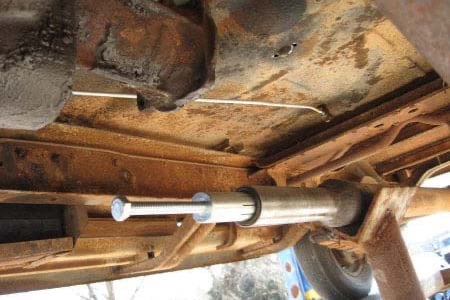
1953 Chevy Truck - Driveshaft and brakes
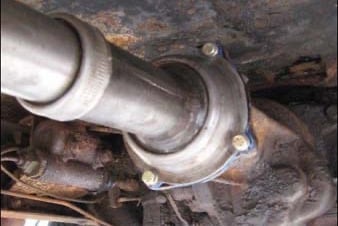

A special tool was required to remove the old front bushing. The beauty of this solution is the Okie seal and bushings fit in front of the original rear bushing and seal. Not only does this make disassembly of the rear axle unnecessary, it also allows the new seal to ride on a new, unworn, portion of the driveshaft.
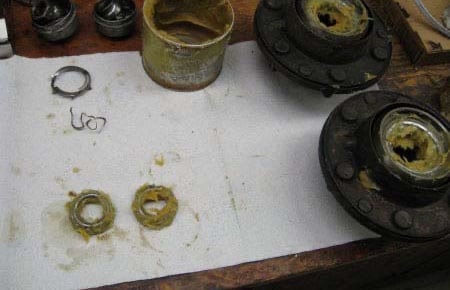

The front wheel bearings are of the ball type rather than the tapered (Timken) type more commonly used today. They were repacked with some old-style fibrous grease we had on the shelf. This particular grease is the type originally used but updated enough to withstand the extra heat generated by disc brakes. We felt this product was a good compromise between the old and the new.
The 3 shiny steel pieces in the upper left were 'spare parts' found inside the left front dust cap. No other damaged pieces were found so it appears these may have been overlooked some time, perhaps when a bad wheel bearing was replaced; Another good reason for always putting things together "clean." All ball bearings and races were in excellent condition.
The front hubs were installed and the spindle nuts torqued to 33 ft lbs, as specified in the factory service manual. Now the truck should go safely down the road. It's time to take another look at getting it running better. We still need to see why the vacuum advance in the distributor isn't working right. We're planning to update to electronic ignition and a higher voltage coil. This should help some with easier starting since the truck will be expected to spring to life relatively easily despite intermittent use. Along those same lines, we're contemplating fitting an electric fuel pump to push fuel up into the carburetor for initial starts. This will minimize the effect of the carburetor 'drying out' when sitting for more than a day or two between assignments.. The truck will most likely be asked to start and run dependably by a variety of drivers, most of whom won't want to deal with too many 'eccentricities.'
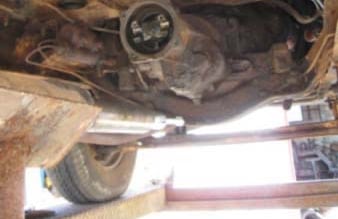

The next step was to open things up between the back of the transmission and the front of the torque tube.
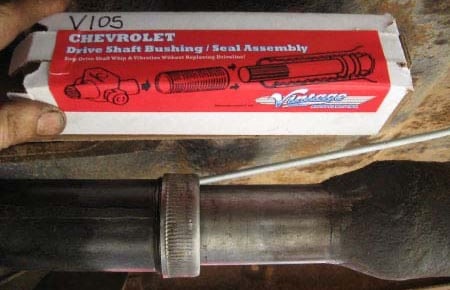

Inside the front of the torque tube the driveshaft rides on two bushings and a seal. When the seal gets old the transmission fluid starts seeping from the transmission to the rear axle. The Chevrolet service manual calls for disassembling the rear axle housing in order to drive the bushings and seal out from the rear to front. The aftermarket has come to the rescue with what's unofficially known as an "Okie seal", making rear axle disassembly unnecessary. The Okie seal is actually a seal and 2 new bushings, made as one complete assembly driven in from the front of the torque tube.
There are two stories about the origin of the name "Okie Seal." The first is that the '"Okies" were the only ones who drove these old trucks long enough to wear out the bushings and seal in the front of the torque tube. The second story claims the reason for the moniker "Okie Seal" is that the aftermarket repair piece was invented right here in Oklahoma. In all likelihood, both stories may have some factual basis.........
Thanks to Bob Adler of Adler's Antique Autos in Stephentown, N.Y. for making us aware of the Okie seal solution.
The torque tube bell was sealed with new gaskets and reassembled. The gaskets are referred to as shims and number used determines the fit and mobility of the bell flange. Some staining of the exhaust pipe can be seen where brake fluid had been dripping out of the master cylinder due to old age.
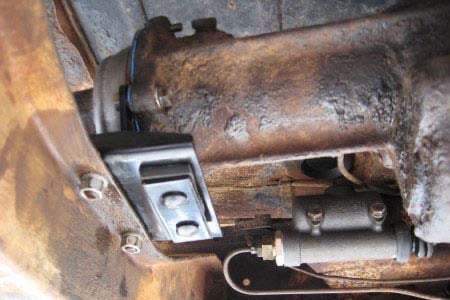

A new master cylinder was fitted. Also, visible is the new transmission mount installed when the crossmember was reassembled. The old one was quite spongy and deteriorated, partly due to the leakage of fluids over the decades. We had originally planned to make new steel brake lines, assuming the old ones would be suspect due to rust. Upon closer inspection it appeared the lines were all in good shape, perhaps able to last several more decades. The rubber brake hoses were a different story. All 3 were replaced.
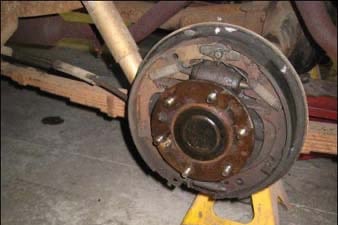

It was initially suspected some of the excess fluid in the rear axle had pushed itself out into the left rear brake drum. Upon disassembly it appeared the wetness there was due to a leaking wheel cylinder. The left front wheel cylinder was also found to be leaking.
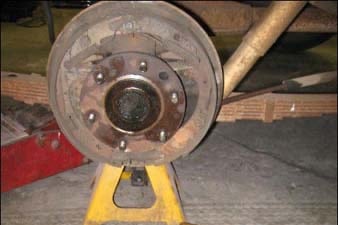

The right rear drum contained a mud dauber nest, originally built on one of the brake shoes. Thankfully, the wetness on this side is just penetrating oil used to get the drum loose from the axle.
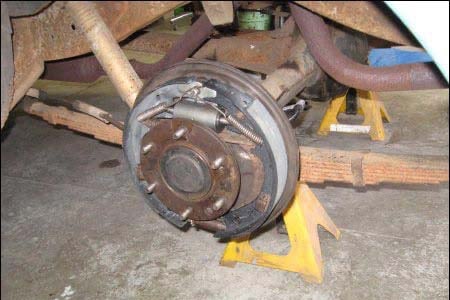

All four wheels had nearly full brake shoe linings, appearing to have traveled very few miles since the last brake job. All four drums were in excellent condition, still showing machine marks from having been turned at some earlier time. The rear shoes were replaced with new (unfouled) ones but the fronts were reusable. New wheel cylinders all the way around and unsticking one frozen adjuster will make this truck stop more like it did when it was new.
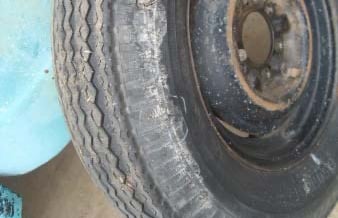

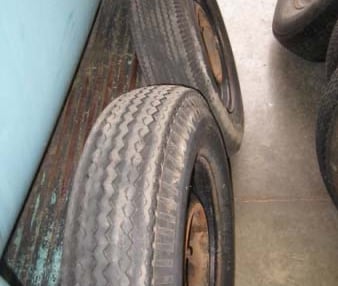

The old bias-ply tires looked pretty good at first glance although the rears are 6.00 X 16 and the fronts 6.50 X 16.
Upon closer inspection it can be seen the front tires had been run underinflated, causing the outer portions of the tread to wear more than the centers. The sidewalls show some wear and tear in the form of cuts and bruises. The tires were rotated front to back after the brake job. Driving after that, the truck's steering wheel began to shimmy uncontrollably approximately 40-45 mph. The tires were rotated back, the steering linkage and front suspension were carefully checked for excessive play or looseness. The only significant play was in the steering box itself. The sector gear in the steering box was subsequently tightened approximately 7/16 of a turn in the middle of it's travel,as per the factory service procedure. After that it appears the likely cause of the shimmy is the old tires themselves.
For now, we'll go on with other issues of the restoration. If new tires at the end don't solve this challenge, we should be able to do whatever is necessary without interfering with fresh paint and cosmetics.
